This is the ninth in my series of articles about how the chess pieces move. This article will cover the rule about the en passant capture. My next article will cover the rule about pawn promotion, and then we’ll move on to the rules about check and checkmate. After that I plan to have a series of articles and videos on how to checkmate, which should be a lot of fun – be sure to look for that. Click the RSS feed button above to be notified through your favorite reader about updates to this blog!
The en passant rule
First, it is easiest to understand this rule by looking at the video. I have a couple of examples I go through, and you should have a good understanding by reviewing the video.
This is the rule (in my own words): when a Pawn is on its fifth rank (f5 for the white Pawn in the diagram below, c4 for the black Pawn) …
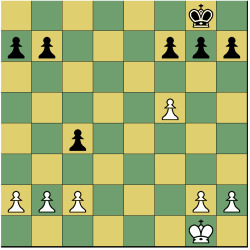
…if an enemy pawn makes a two-step first move, thereby crossing a square that the pawn attacks (a square where the pawn could capture an enemy piece that stands there), for the next move and the next move only, the pawn may capture the enemy pawn as if it had made only a one-step move. (If you want to check the official rule, get the United States Chess Federation’s Official Rules of Chess, Fifth Edition. 🙂
The term en passant is French for “in passing.” Think of it this way: the enemy pawn is trying to “sneak past” your pawn by taking two steps instead of one. Your pawn grabs him by the collar, saying “not so fast!” You capture the enemy pawn “in passing” as it were.
So, if Black moves his Pawn at g7 to g5 … 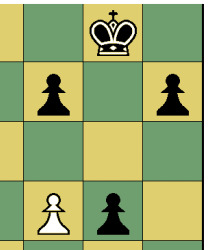
…for the next move ONLY, the White Pawn can capture the Black Pawn as if it stood on g6. 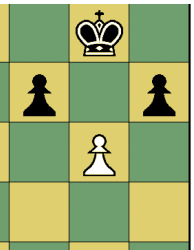 .
.
The same goes for the Black Pawn at c4. If White moves his Pawn to b4 … 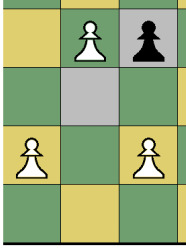
…then Black may capture the White pawn as if it stood on b3. 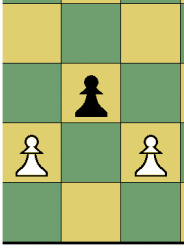
Where does your pawn go after the capture?
When your pawn makes its capture, it goes to the square that it would normally go to in the capture: forward one square diagonally. The enemy pawn is removed from the board and you put your pawn on the square where the enemy pawn would have been standing if it had moved only one step forward on the first move. Look at the video to see the examples.
Only on the next move
If you should come across this opportunity in a game, you must think carefully. In order to make the en passant capture, you must make the capture at the first opportunity. If you make a different move, you lose the right to make the capture. Should your pawn be pinned, or if you happen to be in check from a different piece, or if for any other reason you allow a move to go by without making the en passant capture, you forfeit the opportunity. The move must be made immediately or not at all.
Don’t make the en passant capture just because you can! Make sure that the move is a good one before making it. Don’t capture just because you have the opportunity to capture! Think about the move before you make it.
If you want to learn more about the basic chess rules, chess tactics, and basic strategies, Learn Chess: A Complete Course.
The next article in this series will be on the rules for pawn promotion!

why doesnt anyone mention..you cant en passen while in check!!!
Whoa! Good question! For the answer, check out this link.
Thanks for your comment, scott!
~Steve
Thanks for explaining this move, thank you to you tube for the visuals.
Can you capture a pawn en passant with any other piece other than another pawn?
Say for example a pawn moves two steps on its first move, through the path of a bishop. Would the bishop be able to capture the pawn?
Good question, Lightning! No, only a Pawn can make an en passant capture. The Bishop (or any other piece but a Pawn) has to capture the Pawn where it is, not on the square it has bypassed.
Thanks for your question!
Thankz for your explanation..now i got the en passant very clear now…thank you very much..
Thanks adedayo! 🙂 That’s why we’re here.
What i dont understand regarding the “en passant” capture is… can this move only be done when a pawn moves 2 places out of the starting block and the block he “skippes” is under attack by a pawn, or can it be done when the white pawn is say on A4 and the black pawn on B5 and the white pawn moves from A4 to A5 and doesnt take the black pawn on B5? Can the black pawn on B5 then do the “en passant” move?
Thanks! This is a very common question. It can only be done when the pawn makes an initial 2-step move, “skipping” over a square that is under attack by another pawn. With your second scenario where the white pawn is on a4 and moves to a5, the black pawn at b5 may NOT make the “en passant” capture.
Finally this was described to me in a way that I can understand. Cheers